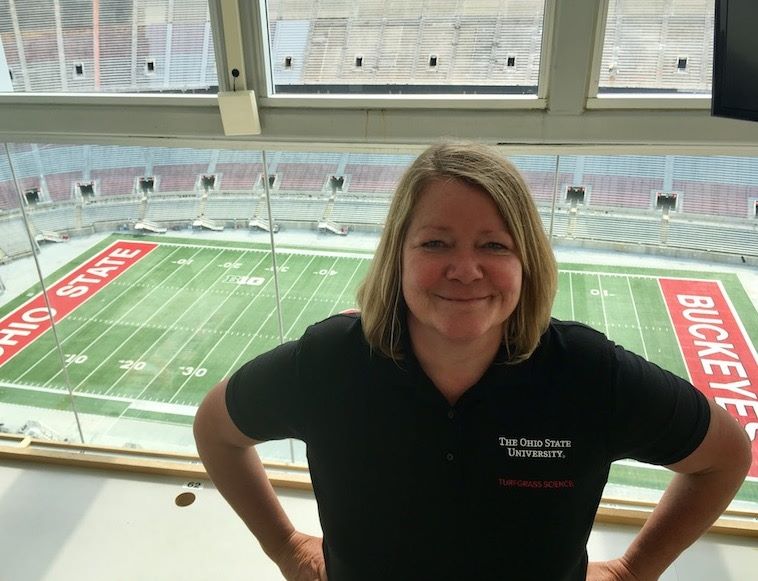Q: How soon can we start an aeration program in spring?
A: This will depend on the type of field and the rationale behind the aeration program.
Soil aeration, also known as soil cultivation, is primarily carried out on native soil fields to improve vertical air and water movement into the rootzone (O2 in, CO2 out), and alleviate soil compaction. Soil compaction (bulk density) is improved if soil is removed (e.g., during hollow core aerification) or if the soil is heaved and fractured (e.g., vertidrain or shatter tine).
The beneficial effects of aeration on soil compaction are greatly increased if coupled with a topdressing program aimed at improving the soil texture. Additional advantages of aeration include improved seed, pesticide and fertilizer placement; dilution and increased degradation of thatch; and promotion of root growth, leading to better water and nutrient uptake by turfgrass roots. On sand-based fields, the primary objective of aeration is to eliminate and dilute surface organic matter, supplemented by a sand topdressing regimen, while also realizing the aforementioned benefits.
It is important to acknowledge certain challenges associated with aeration. Some types of aeration equipment may cause substantial surface disturbance, potentially impacting play, and cause turf damage by uprooting crowns and desiccating roots. The extent of these drawbacks varies depending on the turf’s stress level and the degree of ground cover on the field. A densely covered field undergoing aeration on a mild day is less susceptible to adverse effects compared to a sparsely covered field under hot, windy conditions.
As a general guideline, aeration is most effective under conditions where the turf is not experiencing heat or drought stress, the soil is not frozen, and the soil moisture content is optimal, neither overly wet nor excessively dry. It is not uncommon for native soil fields in cool-season climates to become waterlogged in spring. In those scenarios, postponing aeration until the soil is semi-dry is best.
Cool-season turfgrass species exhibit vigorous, healthy root growth in cooler soils. Root development precedes shoot growth in spring and thrives in soil temperatures between 50-65 degrees Fahrenheit (10-18 degrees Celsius). Thus, roots grow earlier in spring and later in fall compared to shoots. By this rationale, it should be okay to aerate in early spring if the grass has broken dormancy and is able to actively grow and recover from the operation. Many facilities start their aeration programs in late March or early April, depending on local conditions and how early their playing season starts. Most aeration programs include a monthly or bi-monthly aeration in spring and fall, with little or no aeration carried out in July and August.
Since the goal of surviving hot and dry summers depends on grasses having a robust root system, it’s imperative that all action is taken in spring to maximize roots leading into the playing season. Aeration can play a big part in that by relieving soil compaction and opening vertical drainage channels in the soil, allowing for oxygen to enter the soil. Remember that grass roots grow in air spaces, not water. The improved soil conditions also allow those fibrous roots to take up nitrogen fertilizer and water.
Avoid aerating when soil temperatures are above 80 degrees F (26 C), because cool-season grasses have already lost a significant number of roots due to summer heat stress. Cool-season grasses will lose ~50% of their root mass over the summer, and those roots do not grow back until the cooler fall weather arrives.
In addition to local soil and weather conditions dictating the timing of aeration, attention must be given to soil disturbance and weed encroachment. As previously stated, aeration operations cause soil disturbance. If the soil is disturbed, weed seeds in the soil bank might be physically brought up to the surface and spread.
Additionally, germination of some weed species could be triggered by the disturbance. It is best to avoid aeration during peak germination periods of prevalent and problematic weed species; or use equipment that causes little disruption, such as pencil tines. For example, if Poa annua is a major concern, avoid major soil disturbance during its peak germination in the fall. If you are concerned about aerating in spring because of annual weeds such as crabgrass, research has shown that you can apply a preemergence herbicide and then aerate (the aeration does not break the barrier).
Pamela Sherratt is a sports turf extension specialist at The Ohio State University.
Questions?
Send them to Pamela Sherratt at 202D Kottman Hall, 2001 Coffey Road, Columbus, OH 43210 or sherratt.1@osu.edu
Or send your question to Dr. Grady Miller, North Carolina State University, Box 7620, Raleigh, NC 27695-7620, or grady_miller@ncsu.edu


